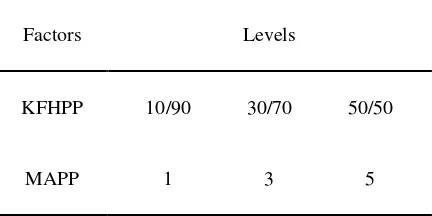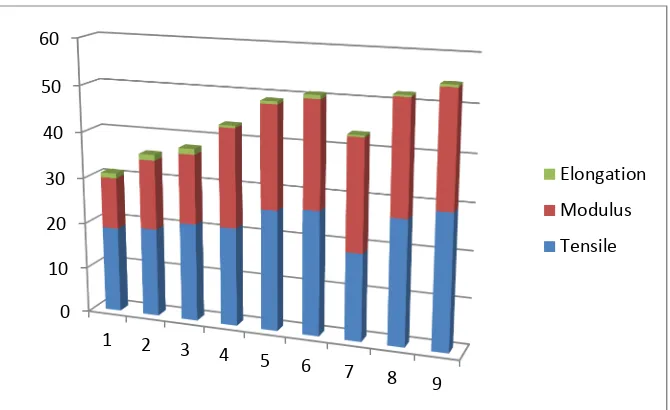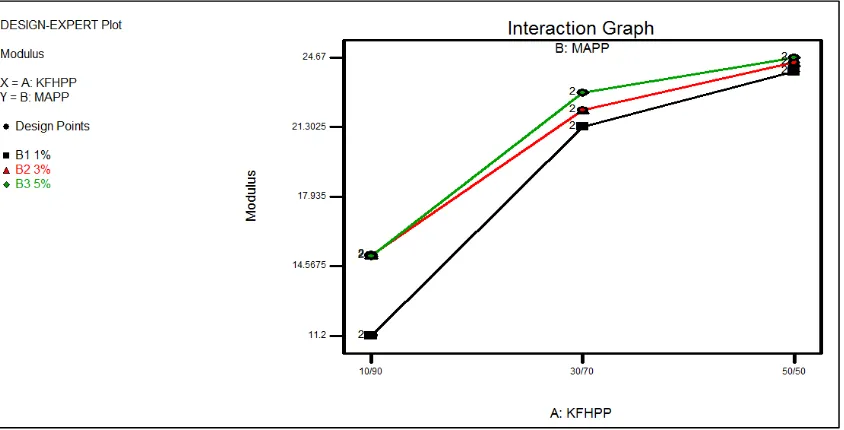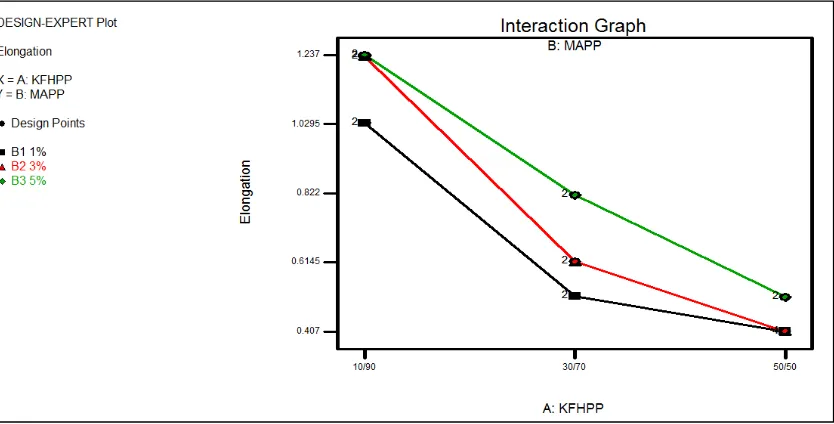7
Evaluation of Mechanical Performance of
Homopolymer Polypropylene/Kenaf Fibre/
/Binder using Full Factorial Method
Mohd Amran *,a, Hazwani Hilmib, Siti Salmahc, Zulkeflee Abdullahd, Effendi Mohamade, Liew Pay Junf and Sivaraosg
Faculty of Manufacturing Engineering, Universiti Teknikal Malaysia Melaka, 76100 Hang Tuah Jaya, Melaka, Malaysia
*,a[email protected], b[email protected], c[email protected], d[email protected], e[email protected], f[email protected], g[email protected]
Abstract – The mechanical performance of kenaf fibre/homopolymer polypropylene/binder composites was studied. Tensile test was used to investigate the tensile strength, tensile modulus and percentage of elongation. Kenaf fibre-homopolymer polypropylene (KFHPP) composites were compounded in an internal batch mixer with the ratio of 10:90, 30:70 and 50:50 in weight fraction. Furthermore, maleated polypropylene (MAPP) as a binder with 1, 3 and 5 % expressed as percentage of weight ratio was mixed in KFHPP composites. A hot pressing machine was used for producing samples of dog bone. From this study, it is found that the tensile strength and tensile modulus increase with increasing kenaf fibre loading and higher percentage of MAPP. In addition, the elongation at break for KFHPP composites shows lower result for increasing kenaf fibre loading. However, when the percentage of MAPP added to KFHPP composites increases, the elongation at break increased slightly. Thus, the result shows that the binder can enhance the interaction between kenaf fibre and homopolymer polypropylene composites, with resulted in better tensile strength and tensile modulus but less function at elongation at break. Copyright © 2014 Penerbit Akademia Baru - All rights reserved.
Keywords: Polypropylene, Kenaf Fibre, MAPP, Full Factorial, Mechanical Performance
1.0 INTRODUCTION
Kalpakjian et al [1] expressed that composite materials have found increasingly wider applications in aircraft, space vehicle, satellites, offshore structures, piping, electronics, automobiles, boats and sporting goods. Therefore, many experiments have been done using various types of reinforcement in compounding of polymer composites such as reinforcement made from PTFE fibre in molten linear homopolymer polypropylene [2], fine fibre [3], kenaf fibre [4] and natural fibre [5]. Almost all reinforcement materials used in polymer composites are able to enhance the mechanical properties [6,7], rheological properties [8,9], and physical properties [10,11]. However, for natural fibre such as cellulosic fibre, which is kenaf core compounded with thermoplastic polymers, the main problem encountered is the poor interfacial adhesion between the hydrophobic polymer and hydrophilic filler. Binder materials have been used in polymer composites to enhance the contact between fibre as a
Article Info
Received 12 October 2014
Received in revised form 30 October 2014
8 reinforcement with polymer as matrix. Various types of binder have been used such as silane, alkoxysilane, maleic-anhydride grafted polypropylene (MAPP), and others. MAPP is widely used as it functions by enhancing the interactions between reinforcement and matrix. Furthermore, the function of MAPP on homopolymer polypropylene composites is also to strengthen the binding between reinforcement and matrix [12]. Therefore, the purpose of this project is to determine the effect of MAPP as a binder on the mechanical properties of homopolymer polypropylene mixed with kenaf fibre at different ratios. The design of experiment using full factorial experimental design was utilized, and the responses of mechanical properties were analysed through statistical method using Design Expert software.
2.0 EXPERIMENTAL
Kenaf fibre was used as a filler and Propelinas G112 homopolymer polypropylene was used as the matrix purchased from Polypropylene (M) Sdn. Bhd. with a density and melt index specified as 0.9 g/cm3 and 11 g/10 min at 230oC, respectively. Polypropylene-graft-maleic anhydride, which is commercially known as maleated polypropylene (MAPP), was selected as the binder for kenaf fibre in homopolymer polypropylene composites. The kenaf fibre filler was cut into smaller length using scissor before it was blend in a blender. The filler was then sieved using a vibratory sieve-shaker machine to obtain the filler size of 120 μm to transferred to a compression mould with the dimensions of 200 mm x 200 mm x 3 mm. Then, the compounds were preheated for 10 min at 200˚C, followed by heating at the same temperature for 10 min with the pressure of 40 kgf and then cold press for 10 min with the same pressure. Three ratios of the kenaf fibre-PP mixtures used were 10:90, 30:70 and 50:50 (w/w). The kenaf fibre/PP compositions and binder percentage used in this study are listed in Table 1. With the help of Design Expert software to analyse the result, full factorial experimental design was selected and the data were analyzed to study the main effects of responses. Two factors (i.e. kenaf fibre/PP ratio and percentage loading of binder) and three levels were used in this experiment. 9 runs were performed with 3 replications based on the equation of full factorial design.
Table 1: Formulations of KFHPP composites and MAPP
Factors Levels
KFHPP 10/90 30/70 50/50
9
3.0 RESULTS AND DISCUSSION
The result of experimental material characteristics on tensile strength, modulus strength and elongation at break is shown in Figure 1.
Figure 1: Mechanical properties for tensile strength, modulus strength and elongation at
break.
3.1 Tensile strength
Figure 1 shows that the tensile strength of KFHPP composites treated with MAPP increased as the MAPP loading increased. The result shows that composites treated with binder at 3% for samples 4, 5, and 6, and 5% for samples 7, 8, and 9 display better tensile strength than those at 1% for samples 1, 2, and 3. Figure 2 shows the interactions of kenaf fibre and MAPP in molten homopolymer polypropylene for tensile strength. It is clear that the increase of kenaf fibre in KFHPP composites enhances tensile strength. The increase of strength of KFHPP composites becomes prominent as the loading of MAPP increases from 3% to high ratio of 5% in KFHPP compositions. Furthermore, high loading of MAPP 5% is significant at the beginning and then reduces as it reached at high loading. This is because the incorporation of binder enhances the tensile strength of the composites, which may be due to a good compatibility at interfacial regions between filler and matrix. M.J. Saad said that a good filler-matrix interaction could be derived from the formation of an ester bond between the anhydride groups of epolene 43 and the hydroxyl groups at the surfaces of kenaf filler [13].
3.2 Tensile modulus
10 which can be seen in Figure 1. Figure 3 shows that the interactions of kenaf fibre and MAPP increased the tensile modulus significantly when the loading of kenaf fibre increased to 30/70 in weight ratio for 1, 3 and 5 % of MAPP. The gap between the interaction of tensile modulus is almost near to each other.
Figure 2: Interaction of kenaf fibre and MAPP for tensile strength.
However, the increase of MAPP binder in the KFHPP composites reduced the tensile modulus slightly compared to low loading of MAPP binder. This is a common phenomenon, which has been reported by other researcher in the case of kenaf-PP composites with Epolene-43. Since kenaf filler has more inherent stiffness than the matrix, the increase in filler loading increased the stiffness of the composites [14].
11
3.3 Elongation at break
The percentage of elongation at break decreased for samples containing more filler as shown in Figure 1. This may be due to the hydrogen bonding bundled in the filler, thus weaken the sample. Kenaf and PP compositions having the ratio of 10:90 with binder show higher elongation at break rather than other formulations of KFHPP composites. Figure 4 shows the interactions of kenaf fibre and MAPP reduced from low loading of kenaf fibre to high loading of kenaf fibre. It shows that high percentage of MAPP at 5% still assists the elongation at break better compared to low loading of MAPP at 1%. The trend line observed by other researchers can also be seen in this study, where more filler loading decreased the elongation at break value [15].
Figure 4: Elongation at break result (a) main effects and (b) surface plot.
4.0 CONCLUSION
This study shows that the tensile and modulus strength of kenaf-PP composites are enhanced by adding binder. The higher the binder loading in KFHPP composites, the better are the mechanical properties for both tensile and modulus strength, but lower for elongation at break. In conclusion, adding a small percentage of MAPP in kenaf fibre/homopolymer polypropylene composites enhances the mechanical properties to a certain value that gives more applications of polypropylene in global market.
ACKNOWLEDGEMENTS
12
REFERENCES
[1] S. Kalpakjian, S. Schmid, (2010). Manufacturing Engineering and Technology, seventh ed., Prentice Hall, New York, 2014, pp. 224-225.
[2] M.A.B. Md Ali, S. Nobukawa, M. Yamaguchi, Morphology development of polytetrafluoroethylene in a polypropylene melt, Pure and Applied Chemistry 83 (10) (2011) 1819-1830.
[3] M. Yamaguchi, K. Fukuda, T. Yokohara, M.A.B. Md Ali, S. Nobukawa, Modification of rheological properties under elongational flow by addition of polymeric fine fibers, Macromolecular Materials and Engineering 297 (7) (2012) 654-658.
[4] H.D. Rozman, S.H. ShanOng, A.B. Azizah, G. S. Tay, Preliminary Study of non-woven composite: effect of needle punching and kenaf fiber loadings on non-non-woven thermoplastic composites prepared from kenaf and polypropylene fiber, Journal of Polymers and the Environment 21 (4) (2013) 1032-1039.
[5] S. Shibata, Y. Cao, I. Fukumoto, Study of the flexural modulus of natural fiber/polypropylene composites by injection molding, Journal of Applied Polymer Science 100 (2) (2006) 911-917.
[6] H. Anuar, A. Zuraida, Improvement in mechanical properties of reinforced thermoplastic elastomer composite with kenaf bast fibre, Composites Part B: Engineering 42 (3) (2011) 462-465.
[7] J. Mirbagher, M. Tajvidi, J.C. Hermanson, I. Ghasemi, Tensile properties of wood flour/kenaf fiber polypropylene hybrid composites, Journal of Applied Polymer Science, 105 (2007) 3054-3059.
[8] M.A.B. Md Ali, K. Okamoto, M. Yamaguchi, T. Kasai, A. Koshirai, Rheological properties for polypropylene modified by polytetrafluoroethylene, Journal of Polymer Science Part B: Polymer Physics 47 (20) (2009) 2008-2014.
[9] T. Yokohara, S. Nobukawa, M. Yamaguchi, Rheological properties of polymer composites with flexible fine fibers, Journal of Rheology 55 (2011) 1205-1219.
[10] H. Peltola, E. Pääkkönen, P. Jetsu, S. Heinemann, Wood based PLA and PP composites: Effect of fibre type and matrix polymer on fibre morphology, dispersion and composite properties, Composites Part A: Applied Science and Manufacturing 61 (2014) 13-22.
[11] M. Suzuki, M.A.M. Ali, K. Okamoto, T. Taniike, M. Terano, M. Yamaguchi, Effect of stereoregularity of polypropylene on flow instability in capillary extrusion, Advances in Polymer Technology 28 (3) (2009) 185-191.
13 [13] M. Saad, Effect of maleated polypropylene (MAPP) on the tensile, impact and thickness swelling properties of kenaf core–polypropylene composites, Journal of Science and Technology 2 (1) (2011) 33-44.
[14] H.D. Rozman, C.Y. Lai, H. Ismail, Z.A.M. Ishak, The effect of coupling agents on the mechanical and physical properties of oil palm empty fruit bunch-polypropylene composites, Polymer International 49 (11) (2000) 1273-1278.



